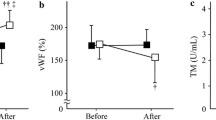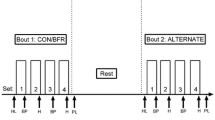Abstract
Purpose
To determine the macrovascular and microvascular function responses to resistance training with blood flow restriction (BFR) compared to high-load resistance training (HLRT) control group.
Methods
Twenty-four young, healthy men were randomly assigned to BFR or HLRT. Participants performed bilateral knee extensions and leg presses 4 days per week, for 4 weeks. For each exercise, BFR completed 3 X 10 repetitions/day at 30% of 1-repetition max (RM). The occlusive pressure was applied at 1.3 times of individual systolic blood pressure. The exercise prescription was identical for HLRT, except the intensity was set at 75% of one repetition maximum. Outcomes were measured pre-, at 2- and 4-weeks during the training period. The primary macrovascular function outcome was heart-ankle pulse wave velocity (haPWV), and the primary microvascular function outcome was tissue oxygen saturation (StO2) area under the curve (AUC) response to reactive hyperemia.
Results
Knee extension and leg press 1-RM increased by 14% for both groups. There was a significant interaction effect for haPWV, decreasing − 5% (Δ−0.32 m/s, 95% confidential interval [CI] − 0.51 to – 0.12, effect size [ES] = − 0.53) for BFR and increasing 1% (Δ0.03 m/s, 95%CI − 0.17 to 0.23, ES = 0.05) for HLRT. Similarly, there was an interaction effect for StO2 AUC, increasing 5% (Δ47%・s, 95%CI − 3.07 to 98.1, ES = 0.28) for HLRT and 17% (Δ159%・s, 95%CI 108.23–209.37, ES = 0.93) for BFR group.
Conclusion
The current findings suggest that BFR may improve macro- and microvascular function compared to HLRT.




Similar content being viewed by others
Availability of data and material
All relevant data are within the paper. The data that support the findings of this study are available from the corresponding author upon reasonable request.
Code availability (software application or custom code)
Not applicable.
Abbreviations
- ATT:
-
Adipose tissue thickness
- AUC:
-
Area under the curve
- BFR:
-
Blood flow restriction
- BMI:
-
Body mass index
- BP:
-
Blood pressure
- bpm:
-
Beats per minute
- CI:
-
Confidential interval
- ES:
-
Effect size
- haPWV:
-
Heart-ankle pulse wave velocity
- HLRT:
-
High-load resistance training
- HR:
-
Heart rate
- MAP:
-
Mean arterial pressure
- NIRS:
-
Near-infrared spectroscopy
- RM:
-
Repetition maximum
- SD:
-
Standard deviation
- StO2 :
-
Tissue oxygen saturation
References
Bopp CM, Townsend DK, Barstow TJ (2011) Characterizing near-infrared spectroscopy responses to forearm post-occlusive reactive hyperemia in healthy subjects. Eur J Appl Physiol 111(11):2753–2761. https://doi.org/10.1007/s00421-011-1898-z
Bopp CM, Townsend DK, Warren S, Barstow TJ (2014) Relationship between brachial artery blood flow and total [hemoglobin+myoglobin] during post-occlusive reactive hyperemia. Microvasc Res 91:37–43. https://doi.org/10.1016/j.mvr.2013.10.004
Credeur DP, Hollis BC, Welsch MA (2010) Effects of handgrip training with venous restriction on brachial artery vasodilation. Med Sci Sports Exerc 42(7):1296–1302. https://doi.org/10.1249/MSS.0b013e3181ca7b06
Cunningham KS, Gotlieb AI (2005) The role of shear stress in the pathogenesis of atherosclerosis. Lab Invest 85(1):9–23. https://doi.org/10.1038/labinvest.3700215
Dankel SJ, Mouser JG, Jessee MB, Mattocks KT, Buckner SL, Loenneke JP (2017) Post-exercise blood flow restriction attenuates hyperemia similarly in males and females. Eur J Appl Physiol 117(8):1707–1712. https://doi.org/10.1007/s00421-017-3663-4
Egginton S (2009) Invited review: activity-induced angiogenesis. Pflugers Arch 457(5):963–977. https://doi.org/10.1007/s00424-008-0563-9
Evans C, Vance S, Brown M (2010) Short-term resistance training with blood flow restriction enhances microvascular filtration capacity of human calf muscles. J Sports Sci 28(9):999–1007. https://doi.org/10.1080/02640414.2010.485647
Fahs CA, Rossow LM, Loenneke JP, Thiebaud RS, Kim D, Bemben DA, Bemben MG (2012) Effect of different types of lower body resistance training on arterial compliance and calf blood flow. Clin Physiol Funct Imaging 32(1):45–51. https://doi.org/10.1111/j.1475-097X.2011.01053.x
Ferguson RA, Hunt JEA, Lewis MP, Martin NRW, Player DJ, Stangier C, Taylor CW, Turner MC (2018) The acute angiogenic signalling response to low-load resistance exercise with blood flow restriction. Eur J Sport Sci 18(3):397–406. https://doi.org/10.1080/17461391.2017.1422281
Hakkinen K, Pakarinen A, Alen M, Kauhanen H, Komi PV (1988) Neuromuscular and hormonal responses in elite athletes to two successive strength training sessions in one day. Eur J Appl Physiol 57(2):133–139. https://doi.org/10.1007/BF00640652
Hopkins WG, Marshall SW, Batterham AM, Hanin J (2009) Progressive statistics for studies in sports medicine and exercise science. Med Sci Sports Exerc 41(1):3–13. https://doi.org/10.1249/MSS.0b013e31818cb278
Horiuchi M, Okita K (2020) Microvascular responses during reactive hyperemia assessed by near-infrared spectroscopy and arterial stiffness in young, middle-aged, and older women. Microvasc Res 129:103972. https://doi.org/10.1016/j.mvr.2019.103972
Horiuchi M, Stoner L (2021) Effects of compression stockings on lower-limb venous and arterial system responses to prolonged sitting: a randomized cross-over trial. Vasc Med 26(4):386–393. https://doi.org/10.1177/1358863X20988899
Horiuchi M, Stoner L (2022) Macrovascular and microvascular responses to prolonged sitting with and without bodyweight exercise interruptions: a randomized cross-over trial. Vasc Med 27(2):127–135. https://doi.org/10.1177/1358863X211053381
Houben A, Martens RJH, Stehouwer CDA (2017) Assessing microvascular function in humans from a chronic disease perspective. J Am Soc Nephrol 28(12):3461–3472. https://doi.org/10.1681/ASN.2017020157
Hunt JE, Galea D, Tufft G, Bunce D, Ferguson RA (2013) Time course of regional vascular adaptations to low load resistance training with blood flow restriction. J Appl Physiol 115(3):403–411. https://doi.org/10.1152/japplphysiol.00040.2013
Karabulut M, Esparza B, Dowllah IM, Karabulut U (2020) The impact of low-intensity blood flow restriction endurance training on aerobic capacity, hemodynamics, and arterial stiffness. J Sports Med Phys Fitness. https://doi.org/10.23736/S0022-4707.20.11526-3
Kenward MG, Roger JH (2010) The use of baseline covariates in crossover studies. Biostatistics 11(1):1–17. https://doi.org/10.1093/biostatistics/kxp046
Kim ED, Tanaka H, Ballew SH, Sang Y, Heiss G, Coresh J, Matsushita K (2018) Associations between kidney disease measures and regional pulse wave velocity in a large community-based cohort: the atherosclerosis risk in communities (ARIC) study. Am J Kidney Dis 72(5):682–690. https://doi.org/10.1053/j.ajkd.2018.04.018
Kooijman M, Thijssen DH, de Groot PC, Bleeker MW, van Kuppevelt HJ, Green DJ, Rongen GA, Smits P, Hopman MT (2008) Flow-mediated dilatation in the superficial femoral artery is nitric oxide mediated in humans. J Physiol 586(4):1137–1145. https://doi.org/10.1113/jphysiol.2007.145722
Krentz AJ, Clough G, Byrne CD (2009) Vascular disease in the metabolic syndrome: do we need to target the microcirculation to treat large vessel disease? J Vasc Res 46(6):515–526. https://doi.org/10.1159/000226220
Liao CW, Lin LY, Hung CS, Lin YT, Chang YY, Wang SM, Wu VC, Wu KD, Ho YL, Satoh F, Lin YH (2016) Time course and factors predicting arterial stiffness reversal in patients with aldosterone-producing adenoma after adrenalectomy: prospective study of 102 patients. Sci Rep 6:20862. https://doi.org/10.1038/srep20862
Lin L, Niwayama M, Shiga T, Kudo N, Takahashi M, Yamamoto K (2000) Influence of a fat on muscle oxygenation measurement using near-IR spectroscopy: quantitative analysis based on two-layered phantom experiments and Monte Carlo simulation. Front Med Biol Eng 10(1):43–58. https://doi.org/10.1163/15685570052061531
Lin YH, Lin LY, Chen A, Wu XM, Lee JK, Su TC, Wu VC, Chueh SC, Lin WC, Lo MT, Wang PC, Ho YL, Wu KD, Group TS (2012) Adrenalectomy improves increased carotid intima-media thickness and arterial stiffness in patients with aldosterone producing adenoma. Atherosclerosis 221(1):154–159. https://doi.org/10.1016/j.atherosclerosis.2011.12.003
Liu Y, Jiang N, Pang F, Chen T (2021) Resistance training with blood flow restriction on vascular function: a meta-analysis. Int J Sports Med 42(7):577–587. https://doi.org/10.1055/a-1386-4846
Loenneke JP, Wilson JM, Wilson GJ, Pujol TJ, Bemben MG (2011) Potential safety issues with blood flow restriction training. Scand J Med Sci Sports 21(4):510–518. https://doi.org/10.1111/j.1600-0838.2010.01290.x
Madarame H, Neya M, Ochi E, Nakazato K, Sato Y, Ishii N (2008) Cross-transfer effects of resistance training with blood flow restriction. Med Sci Sports Exerc 40(2):258–263. https://doi.org/10.1249/mss.0b013e31815c6d7e
Mancini DM, Bolinger L, Li H, Kendrick K, Chance B, Wilson JR (1994) Validation of near-infrared spectroscopy in humans. J Appl Physiol 77(6):2740–2747. https://doi.org/10.1152/jappl.1994.77.6.2740
Ozaki H, Yasuda T, Ogasawara R, Sakamaki-Sunaga M, Naito H, Abe T (2013) Effects of high-intensity and blood flow-restricted low-intensity resistance training on carotid arterial compliance: role of blood pressure during training sessions. Eur J Appl Physiol 113(1):167–174. https://doi.org/10.1007/s00421-012-2422-9
Paiva FM, Vianna LC, Fernandes IA, Nobrega AC, Lima RM (2016) Effects of disturbed blood flow during exercise on endothelial function: a time course analysis. Braz J Med Biol Res 49(4):e5100. https://doi.org/10.1590/1414-431X20155100
Patterson MS, Chance B, Wilson BC (1989) Time resolved reflectance and transmittance for the non-invasive measurement of tissue optical properties. Appl Opt 28(12):2331–2336. https://doi.org/10.1364/AO.28.002331
Pereira-Neto EA, Lewthwaite H, Boyle T, Johnston K, Bennett H, Williams MT (2021) Effects of exercise training with blood flow restriction on vascular function in adults: a systematic review and meta-analysis. PeerJ 9:e11554. https://doi.org/10.7717/peerj.11554
Roth SM, Martel GF, Ivey FM, Lemmer JT, Metter EJ, Hurley BF, Rogers MA (2000) High-volume, heavy-resistance strength training and muscle damage in young and older women. J Appl Physiol 88(3):1112–1118. https://doi.org/10.1152/jappl.2000.88.3.1112
Schulz KF, Altman DG, Moher D, Group C (2010) CONSORT 2010 statement: updated guidelines for reporting parallel group randomized trials. Ann Intern Med 152(11):726–732. https://doi.org/10.7326/0003-4819-152-11-201006010-00232
Soares RN, Murias JM (2018) Near-infrared spectroscopy assessment of microvasculature detects difference in lower limb vascular responsiveness in obese compared to lean individuals. Microvasc Res 118:31–35. https://doi.org/10.1016/j.mvr.2018.01.008
Soares RN, Reimer RA, Murias JM (2017) Changes in vascular responsiveness during a hyperglycemia challenge measured by near-infrared spectroscopy vascular occlusion test. Microvasc Res 111:67–71. https://doi.org/10.1016/j.mvr.2017.01.003
Spronck B, Obeid MJ, Paravathaneni M, Gadela NV, Singh G, Magro CA, Kulkarni V, Kondaveety S, Gade KC, Bhuva R, Kulick-Soper CM, Sanchez N, Akers S, Chirinos JA (2022) Predictive ability of pressure-corrected arterial stiffness indices: comparison of pulse wave velocity, cardio-ankle vascular index (CAVI), and CAVI0. Am J Hypertens 35(3):272–280. https://doi.org/10.1093/ajh/hpab168
Takada S, Okita K, Suga T, Omokawa M, Kadoguchi T, Sato T, Takahashi M, Yokota T, Hirabayashi K, Morita N, Horiuchi M, Kinugawa S, Tsutsui H (2012) Low-intensity exercise can increase muscle mass and strength proportionally to enhanced metabolic stress under ischemic conditions. J Appl Physiol 113(2):199–205. https://doi.org/10.1152/japplphysiol.00149.2012
Takarada Y, Takazawa H, Sato Y, Takebayashi S, Tanaka Y, Ishii N (2000) Effects of resistance exercise combined with moderate vascular occlusion on muscular function in humans. J Appl Physiol 88(6):2097–2106
Zhou J, Li YS, Chien S (2014) Shear stress-initiated signaling and its regulation of endothelial function. Arterioscler Thromb Vasc Biol 34(10):2191–2198. https://doi.org/10.1161/ATVBAHA.114.303422
Acknowledgements
We appreciate the time and effort spent by our volunteers. We also thank Ms. Junko Endo for her technical assistance.
Funding
This work was supported in part by Japan Society for the Promotion of Science (JSPS, KAKENHI, Number; JP18K11012 to M.H.).
Author information
Authors and Affiliations
Contributions
MH, LS, and JP conceived and designed the study. MH performed the experiments. MH, LS, and JP analyzed and interpreted results. MH drafted the first manuscript. LS, and JP critically revised the manuscript, and all authors approved the final version of the manuscript.
Corresponding author
Ethics declarations
Conflict of interest
No conflict of interest, financial or otherwise, are declared by the authors.
Ethics approval and consent to participate
All study procedures were approved by the ethical committee of the Yamanashi Institute of Environmental Science University of Yamanashi (Mount Fuji Research Institute after renaming) in Japan and performed in accordance with the Declaration of Helsinki 2013 (ECHE-03-2012), with written informed consent obtained from all study participants.
Additional information
Communicated by I. Mark Olfert.
Publisher's Note
Springer Nature remains neutral with regard to jurisdictional claims in published maps and institutional affiliations.
Rights and permissions
Springer Nature or its licensor (e.g. a society or other partner) holds exclusive rights to this article under a publishing agreement with the author(s) or other rightsholder(s); author self-archiving of the accepted manuscript version of this article is solely governed by the terms of such publishing agreement and applicable law.
About this article
Cite this article
Horiuchi, M., Stoner, L. & Poles, J. The effect of four weeks blood flow restricted resistance training on macro- and micro-vascular function in healthy, young men. Eur J Appl Physiol 123, 2179–2189 (2023). https://doi.org/10.1007/s00421-023-05230-3
Received:
Accepted:
Published:
Issue Date:
DOI: https://doi.org/10.1007/s00421-023-05230-3




